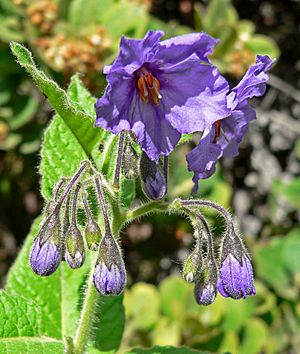Catalina nightshade facts for kids
Quick facts for kids Catalina nightshade |
|
|---|---|
 |
|
| Scientific classification | |
| Genus: |
Solanum
|
| Species: |
wallacei
|
Solanum wallacei, also known as Catalina nightshade, Wallace's nightshade, Northern island nightshade, or wild tomato, is a plant that grows back every year. It has pretty purple flowers, but its leaves and dark purple-black berries are poisonous. Even though it looks a bit like a tomato plant, it's important not to eat any part of it!
What is Catalina Nightshade?
Catalina nightshade is a type of plant that lives for many years. It is known for its bright purple flowers. The plant's leaves and its small, dark berries look a bit like a tomato plant. However, all parts of the Catalina nightshade, especially its berries, are poisonous if eaten.
Where Does it Grow?
This special plant is quite rare. It naturally grows in canyons and on hillsides. You can find it on two of the three Channel Islands in California. It also grows on Guadalupe Island, which is off the coast of Baja California in Mexico. The plant usually blooms, or shows its flowers, in April and May.
Who Was William Allen Wallace?
The plant Solanum wallacei is named after a person called William Allen Wallace. He lived from 1815 to 1893. William Allen Wallace was a plant collector. He gathered samples of plants from the Los Angeles area around the year 1854. Another plant, the woolly daisy (Eriophyllum wallacei), is also named after him.
See also
 In Spanish: Tomate salvaje para niños
In Spanish: Tomate salvaje para niños

